


A Study Guide About Dance, Ecology, and History "
Part I.
I. The Fertile Earth
(Return to Table of Contents/next section)
The fertile earth and waters of Cambodia provide sustenance for her people. They also offer relief from the intense tropical heat: people relish the shade of trees and forests, and the chill of flowing rivers and streams. In addition, people construct houses and everyday accoutrements such as fishing traps from natural elements. In an agrarian and fishing society such as Cambodia, the earth and the waters are honored as powerful and significant in people’s lives through a variety of rituals. The power of nature is at once respected, and adapted to human needs. Thus the spirits of the land and the water figure prominently in local and even national ceremonies. Dance and music are often central in such rites. In this guide you will find discussions of history, tales, ecology, and art, all intimately tied to the land and the water that makes up the country of Cambodia.
II. Water
(Return to Table of Contents/next section)
On a map of Cambodia, the huge body of water sitting in the northwest section of the country is the Tonle Sap, a great freshwater lake that is a unique natural wonder. During the rainy season, roughly June through October, the Tonle Sap River –- which usually flows from the lake -- reverses direction, flooding the lake instead. The lake expands to about ten times its normal size, with water engulfing the surrounding forests and farmland. As a result of this process, fresh, fertile silt, ideal for the cultivation of rice, covers the countryside. The Tonle Sap then becomes the largest freshwater lake in all of Southeast Asia. The lake yields many tons of fish per square mile, providing a major source of sustenance for the population. Indeed, the popular Cambodian saying, “Where there is water, there are fish,” refers to this phenomenon. As the water recedes, children run through the fields, catching fish with hand-held traps.
 On a map of Cambodia one also notices a long river cutting through the country’s eastern part. This is the Mekong whose meandering course takes it from the Himalayan Mountains through China, Laos, and Thailand, as well as Cambodia, on its way to the South China Sea through Vietnam. Cambodia’s rivers and lakes together form a lifeline for this predominantly agricultural and fishing society.
On a map of Cambodia one also notices a long river cutting through the country’s eastern part. This is the Mekong whose meandering course takes it from the Himalayan Mountains through China, Laos, and Thailand, as well as Cambodia, on its way to the South China Sea through Vietnam. Cambodia’s rivers and lakes together form a lifeline for this predominantly agricultural and fishing society.
Water dominates not only the country’s map, but much of its rhythm of life, from the backbreaking labor in the paddies and orchards, to the spiritual realm. Carvings on Cambodia’s ancient stone temples depict everyday existence along the waters, and the impact of seasonal changes. Today, just as long ago, people strive to co-exist with nature so that their fields and families prosper. Irrigation projects, whether huge reservoirs or small dykes, help guide the flow of water as needed. Prayers to the gods and spirits, sometimes in the form  of sacred dance and music, acknowledge the power and importance of water, especially rain. Buddhist monks change their routines according to the dry and the wet seasons. They ordinarily walk through their village or neighborhood on daily morning rounds, accepting offerings of rice and other foods from people in homes and shops along the way. But, for the duration of the rainy season, they retreat to temple compounds. They re-emerge at its conclusion following great festivities.
of sacred dance and music, acknowledge the power and importance of water, especially rain. Buddhist monks change their routines according to the dry and the wet seasons. They ordinarily walk through their village or neighborhood on daily morning rounds, accepting offerings of rice and other foods from people in homes and shops along the way. But, for the duration of the rainy season, they retreat to temple compounds. They re-emerge at its conclusion following great festivities.
Water. Even the word is part of how Cambodians refer to their country. Instead of saying, for example, “the land of Cambodia,” they say, “the water and land of Cambodia,” tik dey Khmer.
III. Dance Focus: Chhayam
(Return to Table of Contents/next section)
Chhayam features drummers and comic, sometimes flirtatious dancers. A line of men playing decorated long drums sets the rhythmic atmosphere that is enhanced by their call-and-response singing, 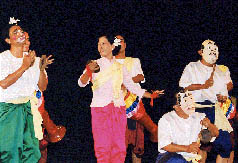 and by the movements and percussive sounds made by dancers who clap hand cymbals or wooden clackers. The dancers may wear comic masks, or paint their faces in humorous ways. One sees Chhayam at the head of processions to and through Buddhist temple complexes on ceremonial occasions, such as the marking of the end of the monks’ rainy season retreat. At such an event, hundreds of celebrants circle the sanctuary three times as an act of reverence, with the Chhayam drummers and dancers helping to create a feeling of joy and togetherness, in the lead. Chhayam, considered a folk dance, is popular in both the countryside and the cities.
and by the movements and percussive sounds made by dancers who clap hand cymbals or wooden clackers. The dancers may wear comic masks, or paint their faces in humorous ways. One sees Chhayam at the head of processions to and through Buddhist temple complexes on ceremonial occasions, such as the marking of the end of the monks’ rainy season retreat. At such an event, hundreds of celebrants circle the sanctuary three times as an act of reverence, with the Chhayam drummers and dancers helping to create a feeling of joy and togetherness, in the lead. Chhayam, considered a folk dance, is popular in both the countryside and the cities.
Activities:IV. DANCE AND RAIN by Toni Shapiro-Phim1. Make papier-mâché masks with comic or exaggerated features and expressions.
2. Discuss parades students have seen or participated in in comparison with a procession to and through a Buddhist temple. In what context are those other parades held? Who leads the parade? Why?
(Return to Table of Contents/next section)
Once upon a time there lived a hermit, famous for his skills in magic. He was generous with his knowledge, teaching many students in his forest dwelling. One day he challenged two of his students to a contest. Calling the goddess Moni Mekhala and the giant Ream Eyso to his side, he instructed them each to take an empty glass he was offering, and to return the next day with the same glass filled with morning dew. “I will reward the first of you to complete the assignment with a prize,” he said.
So Moni Mekhala and Ream Eyso went to their respective homes, eager to be the winner, for each respected the hermit, and wanted to please him. Each wanted the prize as well! Ream Eyso was pretty confident. “This isn’t a complicated task at all,” he thought to himself. He had a good night’s sleep, and first thing the next morning, started collecting dew. Spotting leaves with droplets upon them, he pinched and squeezed one leaf after another, methodically filling his glass, drip by drip.
Moni Mekhala, on the other hand, felt it best to begin that very night. After careful consideration, she placed a piece of cotton flat upon the grass. When she awakened the following morning, dew had soaked the cloth. She picked it up and with one twist, filled her cup. Off she went to present her teacher with the glass of dew.
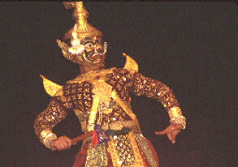 The hermit was indeed pleased with Moni Mekhala’s cleverness. She returned to her teacher first, task completed, and thus won the prize. The hermit took her glass of morning dew, and from it, fashioned a magic jeweled ball. This ball was so powerful, the teacher explained, that Moni Mekhala was to guard it carefully, as with it, she could do many wondrous things. “I am ever so grateful, teacher. And I will use it wisely,” Moni Mekhala said before she took her leave.
The hermit was indeed pleased with Moni Mekhala’s cleverness. She returned to her teacher first, task completed, and thus won the prize. The hermit took her glass of morning dew, and from it, fashioned a magic jeweled ball. This ball was so powerful, the teacher explained, that Moni Mekhala was to guard it carefully, as with it, she could do many wondrous things. “I am ever so grateful, teacher. And I will use it wisely,” Moni Mekhala said before she took her leave.
Soon thereafter, Ream Eyso appeared in the forest before his teacher, full glass in hand. He didn’t see the goddess, so assumed he had gotten there first. When his teacher told him that he was in fact the second to have shown up, the giant was enraged. And when he then learned that Moni Mekhala possessed a magic ball – the prize – he grew even angrier. His teacher did give him a consolation prize. It was a sparkling axe, powerful in its own right, but not quite as powerful as the ball that Moni Mekhala had. In a huff, full of jealousy, Ream Eyso took off in pursuit of his rival. He just had to have that ball.
Ream Eyso found Moni Mekhala enjoying an outing with other deities, singing and dancing in the heavens. Unable to control himself, he pushed the other deities to the side, and faced Moni Mekhala directly, demanding her magic ball. Moni Mekhala, never losing her composure, even in the face of the high-stomping giant, distanced herself with grace from his outstretched hand, curved in the shape of a claw. Ream Eyso grew so frustrated that he eventually hurled his axe at the goddess, barely missing her. So awesome was the impact, though, that the heavens shook. In response, Moni Mekhala tossed her ball into the air. Its glow was such that the skies lit up, blinding Ream Eyso, who then fell to the ground. Moni Mekhala escaped into the clouds, safe for the time being from the greediness of the giant. Moments later, however, Ream Eyso wiped his eyes, and, regaining his bearings, realized that she had gotten away. Promising to renew the encounter another time, he, too, slipped into the clouds.
Cambodians see in this story the origin of thunder (the crash of the axe) and lightning (the radiance of the ball) which together produce rain, rain that is so critical to the well-being of the country and her people. At least once a year, for centuries, a ceremony has been performed in Cambodia in which dance and music form the communication link to the gods and spirits to ask for rain and other blessings for the country. Sponsored by the royalty, the ceremony features the dancing of sacred stories, including the story of Moni Mekhala and Ream Eyso, as a way of calling forth rain at the height of the hot season. If pleased with the offering of dance and music, it is believed, the deities will allow the rain to fall, thus getting the next cycle of planting and growth off to a good start.
Dancers selected for the roles of Moni Mekhala and Ream Eyso must participate in a special ceremony of their own before they are allowed to perform. Each role, being so important and powerful, requires the blessings of teachers and spirits of the dance. Thus only certain accomplished dancers may perform as the goddess or the ogre, and only after receiving the necessary blessings. When they do perform, along with lines of dancers representing lesser deities, and accompanied by a pin peat orchestra composed mostly of xylophones, gongs, and drums, the public watches a tale it knows so well come to life, a tale whose enactment is part of the nation’s relationship to the land and water that sustain it.
Activity:V. Dance Focus: MakarCompare thunder and lightning origin stories from various places, including how the students’ parents or grandparents have explained this, for example.
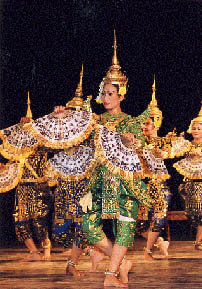
(Return to Table of Contents/next section)
Another classical dance in which Moni Mekhala, the goddess of the seas, appears, is called Makar. Makar is the name of a mythical sea creature, one who represents the fertility of bodies of water. The Makar dance opens with a solo by a divine prince, Vorachhun. (Vorachhun, a companion of Moni Mekhala, is also a character in the long version of the Moni Mekhala-Ream Eyso story, described above.) The second part of the dance features Moni Mekhala and an entourage of dancers manipulating fans in imitation of the scales of a makar as they move in winding patterns, just as that animal might.
VI.STUDENTS OF DANCE IN CAMBODIA by Toni Shapiro-Phim
(Return to Table of Contents/next section)
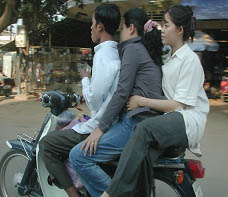 Sina and Sophal climb on the motorcycle seat behind their father every morning at about 6:30. The streets of Cambodia’s capital, Phnom Penh, are already crowded with people going to the markets, or to school or work. By the time the motorcycle makes its way through the traffic to the north end of the city, the home of the dance department of the Royal University of Fine Arts, it is close to 7:00. Sina and Sophal slide off the seat, say good-bye to their father, and begin their day at school.
Sina and Sophal climb on the motorcycle seat behind their father every morning at about 6:30. The streets of Cambodia’s capital, Phnom Penh, are already crowded with people going to the markets, or to school or work. By the time the motorcycle makes its way through the traffic to the north end of the city, the home of the dance department of the Royal University of Fine Arts, it is close to 7:00. Sina and Sophal slide off the seat, say good-bye to their father, and begin their day at school.
Sina, 13, has been a student of dance for five years. Her brother Sophal, 10, is in his third year of studies. Sina and her girlfriends help each other dress in their practice outfits. On top they wear tight-fitting button-down dance shirts. They wrap lengths of cloth (3 feet each) around their waists, then twist the ends together and pull them through their legs to make pantaloons that are held in place with a silver belt. Boys, on the other hand, wear tee shirts and sweat pants, or other loose fitting clothes. Once ready, they sit in lines awaiting the arrival of their teachers.
Sina and Sophal are the children of a professional dancer, one who, as an artist with the National Department of Arts, performs the role of the monkey in classical dance-dramas. He has performed on stages throughout the world, from Hong Kong to France, and has danced in religious ceremonies in Cambodia, as well as for tourists. Their grandfather was a classical dancer, too. They grew up surrounded 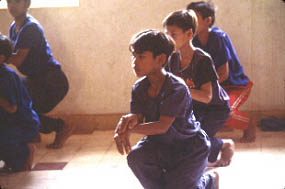 by the sounds, movements, and stories of the dance, and never wanted to do anything else but perform.
by the sounds, movements, and stories of the dance, and never wanted to do anything else but perform.
When their teachers appear before them, the students at the dance department – ranging in age from eight to eighteen – sit absolutely still, in silence. With the tap of a rattan wand on the tile floor, class begins. They start each day’s practice with exercises meant to encourage flexibility and strength, which are very important in Cambodian dance technique. One exercise involves bending the hand backward from the wrist, pushing gently on the fingers with the opposite hand. Some dancers are supple enough to continue until the fingers rest on the forearm. Following these exercises, students practice a series of basic gestures and movements, a sort of vocabulary of the dance. These positions and movement patterns form the base from which actual dances are created. It may take a year or longer to memorize the entire series. Dancers repeat this over and over again, day after day, throughout their years of training.
There are various types of dance in Cambodia. At the dance department, three main types are taught. In the classical dance characters such as princes, goddesses, giants and monkeys, among others enact stories of myth and history. Girls and women play the roles of princes, princesses, gods, goddesses, and giants. Boys and men perform as monkeys, often the “good” characters in opposition to the evil giants. Both boys and girls perform folk dances, which often reflect ideas about life in Cambodia’s countryside. In the third form of dance, called lakhon khol, boys and men, mostly wearing masks, play all the roles. Students practice together for their first years at school. They are then selected to specialize in classical or folk dance or lakhon khol.
Both Sina and Sophal hope to be classical dancers. Sina, because she is so petite, is studying the “female” steps – those of a princess or goddess. And Sophal, of course, is a young “monkey.” Their teachers demonstrate 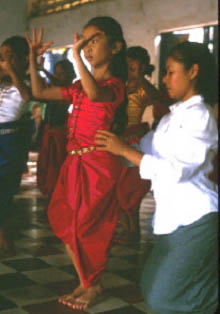 a sequence of movements and have them imitate. Moving along the lines of dancers, the teachers press behind the students’ shoulder blades to help them open their shoulders, or push their elbows in, etc., molding them into correct position. Studying Cambodian dance can be painful, with muscles all over the body energized. It is also exhausting. There is one official rest period in the four hours of morning practice. Sina and Sophal can hardly wait for lunch and a nap at home.
a sequence of movements and have them imitate. Moving along the lines of dancers, the teachers press behind the students’ shoulder blades to help them open their shoulders, or push their elbows in, etc., molding them into correct position. Studying Cambodian dance can be painful, with muscles all over the body energized. It is also exhausting. There is one official rest period in the four hours of morning practice. Sina and Sophal can hardly wait for lunch and a nap at home.
They return to the school for afternoon classes in math, literature, science, history and so on. Public school in Cambodia is held half a day, and students of dance get the same academic training as do students in other schools.
Dance students have a special relationship with their dance teachers. They bring them incense, and sometimes flowers and candles, every Thursday (considered “teachers’ day”), as a form of respect. In return, the teachers bless them with prayers for successful careers as artists, and for the strength to carry on the cultural heritage of the country.
Sina and Sophal’s father, as well as their teachers, suffered enormously under the rule of the Khmer Rouge from 1975-1979. They saw the artistic and cultural heritage of Cambodia nearly wiped out during that time, when close to two million people out of a population of seven or eight million died from starvation, disease, forced labor, and execution. Surviving dancers estimated that perhaps ninety percent of their professional colleagues perished under the harsh conditions imposed by the Khmer Rouge, including Sina and Sophal’s grandfather. Cambodia’s artists have struggled hard to rebuild that heritage over the past twenty-two years. And now their children, and their students, are carrying the myths, stories, and movements on for yet another generation.
Activity:VII. Music in Cambodia1. Try the finger flexibility exercise described in the passage above. Be careful not to push too hard!
2. See dance-on-paper activity on following pages.
(Return to Table of Contents/next section)
Cambodia has a rich and varied musical tradition. There are numerous distinct ensembles, each meant to accompany certain kinds of events or activities, such as weddings, funerals, parties, religious ceremonies, folk songs and dances, and so on.
The pin peat ensemble plays with classical dance, Buddhist temple ceremonies, lakhon khol (all-male dance-drama), and shadow puppet plays. It is made up of xylophones, gongs, cymbals, drums, and an oboe-like instrument.
Excellent background and activities, including percussion comparisons, can be found at: www.research.umbc.edu/eol/cambodia/index.htm.VIII. Cambodian Dance in the U.S.A.
(Return to Table of Contents/next section)
(from the Danse Celeste Web Site:Since 1979, more than 200,000 Cambodians have fled the war and despair of their homeland, and made new homes here in the United States. There are large concentrations of Cambodians in Long Beach, California (50,000), Lowell, Massachusetts, and many other American cities. They come from all levels of society. They come from the many regions of Cambodia. But what they have in common is their traditional language, religion, food, music and dance. These are important ways which allow them to identify themselves as ethnic Khmer.
www.anaserve.com/~danseceleste/history.htm)
Many of the dancers now living in the U.S. originally learned to dance in the refugee camps along the Thai-Cambodian border. Former palace stars, and others who had learned the dance second or third hand, found many eager apprentices just waiting for an opportunity to bring beauty and grace into the dreary existence of camp life. That is part of the reason why wherever there are Cambodians, there is classical dance. It is practiced by college student associations, community service organizations, and informal cultural groups. Their level of experience varies, but their passion is the same, and if that means studying from pirated video tapes in the absence of professional master dancers, then that is what they do.
Although originally a royal tradition, classical dance has become an egalitarian art form that Cambodians use to celebrate their traditional holidays, to pass on ideas about classical aesthetics, and as a source of ethnic pride. It unites Cambodian communities whether they are in Long Beach, Lowell, Sydney, Paris, or Phnom Penh.
A Dancer’s Story: Cathleen Kim
(Return to Table of Contents/next section)
“I was about eight or nine years old when I first saw Cambodian dance,” says 20-year-old Cathleen Kim. “And I loved it from the beginning. Maybe it was the gracefulness of the dance, or the beauty of the music...” Cathleen was living in Texas at the time, and used to accompany her father to events sponsored by the local Cambodian association with which he was affiliated. Cambodian-American kids would perform dances at many of these events, and Cathleen was hooked. When she moved to Long Beach, California, at 13 years of age, she started to study dance with the Cambodian Arts Preservation Group. Her parents were very supportive of her desire to learn this art from their homeland. “My Mom told me she thought it would help me be brave in public. She loved it, too.”
For the past couple of years, Cathleen has been studying classical dance under the tutelage of Sophiline Cheam Shapiro, a graduate of Cambodia’s Royal University of Fine Arts, where she was also a teacher. Calling her, “Neak kru” (respectful title for a female teacher), Cathleen speaks about their relationship. “We have a formal relationship. I look up to her for her dedication to the arts. So I work hard, trying my best in everything she asks us to do. I study with her at least once a week, every Saturday,” at the United Cambodian Community’s Arts of Apsara Cultural Center, in Long Beach. “Often, I also practice on my own.” Lately, Cathleen has become an assistant teacher, helping to run dance classes when Ms. Shapiro was overseas working on a choreographic project in Cambodia, or on maternity leave. “I like teaching the [Cambodian-Americans] raised here in the U.S.,” Cathleen explains. “It’s a great honor to introduce them to a culture they don’t know much about.”
A student majoring in Human Services at Long Beach City College, Cathleen has a full-time course load to handle. But she insists on including Cambodian dance in her schedule. Performances require enormous investments of time. It takes hours to be sewn into costume, so a twenty minute show can take several hours out of her day. “Recently, we performed in a garden setting at a United Cambodian Community-sponsored event. When my friends see me dance, they compliment me for my bravery because they say it is so hard. They don’t have the discipline. They’re impressed with the dance’s flexibility.”
Eventually, Cathleen hopes to be able to spend some time in Cambodia, in residence at the Royal University of Fine Arts. “I’d like to experience what the training is like there,” she says. Having been born in a refugee camp in the Philippines, Cambodia is a spiritual and cultural homeland for her, one she grows closer to with each new dance she learns.
Activity:IX. Dance Focus: The Reamker1. Compare the stories of Sina and Sophal, Niki, and Cathleen. How did each get inspired to dance? What are some similarities and differences in their experience as dancers?
2. Discuss the place of dance and dance classes in your students’ lives as compared to the place of dance and dance classes in the lives described above.
(Return to Table of Contents/next section)
The Reamker is the Cambodian adaptation of the great Indian epic tale, The Ramayana. In one village in Cambodia, a masked dance-drama of this long, complicated story of war, love, and magic, used to be performed over the course of seven nights. These days, performers in that village limit the story to episodes that can be enacted in just three evenings. On stage, because of time constraints, dancers may take under an hour to perform select parts of the tale.
In the narrative, Preah Ream (Preah, here, means Prince), the central character, is exiled to the forest for fourteen years when his step-mother wants her son, Preah Ream’s half-brother, to ascend the throne instead of Preah Ream. Preah Ream embarks on his journey accompanied by his wife, Neang (Princess) Seda, and his brother, Preah Leak. Through trickery, the mean giant Reap kidnaps Neang Seda and takes her to his island kingdom.
One of the most popular episodes in this drama as told and performed in Cambodia is that of the monkeys and mermaids. Their encounter takes place on and in the water. Preah Ream enlists his army of monkeys, under the leadership of Hanuman, to build a bridge to the land of the giants in order to rescue his beloved wife. As the monkeys attempt to lay stones across the sea, their work is frustrated because the stones keep disappearing. They discover that mermaids are removing the boulders as soon as they have placed them on the water. Hanuman, diving to the depths of the ocean, approaches their leader, the “golden mermaid,” Sovann Maccha, expecting to have a confrontation with her. But as he gets closer, he is smitten by her charm. Though she rejects his advances at first, she soon returns his affection. They become allies. With the bridge built, Preah Ream, Preah Leak, and their monkey army are able to attack the giants, and to rescue Neang Seda.
Preah Ream wants to be sure that Neang Seda has kept her love only for him, and he puts her through a trial-by-fire. She emerges unharmed, thus proving to her husband that she has been faithful to him. Preah Ream, Neang Seda, Preah Leak, and Hanuman all return home where Preah Ream gains his rightful place on the throne.
X. Silent Lotus (Activity)
(Return to Table of Contents)
Read the book, Silent Lotus, by Jeanne M. Lee. This is a wonderful book to read aloud to younger students. Older students will also appreciate the story’s themes, and the illustrations. See synopsis below.
The Story of A Girl Who Lived and Danced by the Water
(synopsis of the beautifully written and illustrated book Silent Lotus by Jeanne M. Lee, New York: Farrar, Straus and Giroux, 1991.)
“Long ago in Kampuchea, a man and a woman lived on the edge of a lake. A daughter was born to them. She was beautiful, with a face as round as the moon and eyes as bright as the stars.”
So begins the story of Lotus, a girl of ancient Cambodia. Kampuchea is another word for Cambodia. In fact, in the Cambodian (or Khmer) language, Kampuchea is the way the name of the country is pronounced. Lotus received her name because of her parents’ appreciation of the lotus blossoms covering the lake by their house. Years went by without Lotus learning to speak. Her parents realized that she was deaf. They made a gesture with their hands – all fingers stretching to the sky, forming a kind of bowl – as a way of representing the flower, and the name of their daughter. This was the first hand gesture Lotus learned. But it wouldn’t be the last.
Lotus’ father was a fisherman. While he was out on the lake, casting his net or setting fish traps, his daughter would play along the banks. Often she danced in imitation of the movements of the herons. But though she was happy dancing and playing by the water, she was often lonely. The other children didn’t want her to be with them.
One day her parents decided to go to the huge stone temple a distance from their village to pray for some relief for their daughter’s sadness. While they were there, they saw magnificent dancers. Lotus, feeling the vibrations of the music, imitated the dancers’ movements. At that moment, her parents recognized her calling. Lotus stayed with the dancers, among whom she made many friends, and grew up dancing at the court and the temples. As a dancer she could communicate with all those around her, as well as with the gods.
Suggested discussion questions:(Continue to Part II)1. With whom did Lotus feel most comfortable as a young child, besides her parents? Why?
2. Look at Lotus’s house. Most homes in Cambodia’s countryside, even today, are raised just as hers was. Why do you think people build houses up high like this? (It creates a space below the home in which both animals and people can find shade. It may also be used for storage and activities such as weaving or cooking. It can also offer protection from flooding.)
3. What is the gesture her parents made to represent the word, “lotus”? This is also a hand gesture in Cambodian classical dance that means “flower.”
4. Do you know anyone who is deaf? How does he/she communicate?
5. Why did Lotus’ parents take her to the big temple in the city? What were they hoping for?
6. How could Lotus dance with others if she couldn’t hear?
7. From the readings and activities above (in this guide), what do you think the role of dance was during the days when Lotus danced in the court and at the temples?
(Return to Table of Contents)
(Move to top of page)
